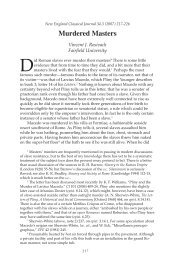Moche Sex Pots: Reproduction and Temporality in ... - Faculty Pages
Moche Sex Pots: Reproduction and Temporality in ... - Faculty Pages
Moche Sex Pots: Reproduction and Temporality in ... - Faculty Pages
You also want an ePaper? Increase the reach of your titles
YUMPU automatically turns print PDFs into web optimized ePapers that Google loves.
500 American Anthropologist Vol. 106, No. . September 2004<br />
FIGURE 1. <strong>Moche</strong> ceramic depict<strong>in</strong>g anal <strong>in</strong>tercourse lAIC<br />
1955.2674). Incised mark<strong>in</strong>gs above the woman s anus resemble<br />
a nose <strong>and</strong> eyes, creat<strong>in</strong>g a t<strong>in</strong>y visual pun that turns the anus <strong>in</strong>to<br />
a mouth. (photo courtesy of the Art Institute of Chicago)<br />
the ceramics, we will f<strong>in</strong>d the one figure that br<strong>in</strong>gs all these<br />
themes together: the ancestor.<br />
MOCHE: WEALTH AND POWER<br />
To describe these ceramics as "<strong>Moche</strong>" can be mislead<strong>in</strong>g if<br />
it implies that they are the products of a s<strong>in</strong>gle homogenous<br />
culture. Ownership of these beautifully executed, pa<strong>in</strong>stak<strong>in</strong>gly<br />
crafted pieces was restricted to a rarified elite; production,<br />
too, was likely controlled by a specialized stratum<br />
of craft producers, for the <strong>Moche</strong> were a highly stratified<br />
society.<br />
More than a millennium after their reign, the ambitions<br />
of <strong>Moche</strong> leaders are still visible <strong>in</strong> their monumental<br />
architecture, such as the massive edifice known as the Huaca<br />
de la Luna, one of the largest man-made constructions <strong>in</strong><br />
the Americas. The looted valuables sold on the antiquities<br />
market <strong>and</strong> coveted by modern buyers likewise demonstrate<br />
the ability of <strong>Moche</strong> elites to surround themselves with luxury<br />
goods <strong>and</strong> works of f<strong>in</strong>e art. Controlled excavations <strong>in</strong><br />
the last decade provide even greater evidence of the degree<br />
of economic <strong>in</strong>equality <strong>and</strong> the concentration of political<br />
power that characterized the <strong>Moche</strong> period.<br />
Not too long ago, archaeologists pictured the <strong>Moche</strong> as<br />
a simpler, smaller predecessor for mighty Chimu, the rich<br />
<strong>and</strong> powerful polity thriv<strong>in</strong>g under nom<strong>in</strong>al Inca control<br />
which Pizarro <strong>and</strong> his men would encounter on the North<br />
Coast 700 years later. In a radical revision, today scholars<br />
argue that the <strong>Moche</strong> period was a time when the political<br />
economy of the region rapidly coalesced <strong>in</strong>to someth<strong>in</strong>g<br />
qualitatively unlike its predecessors <strong>and</strong> far more unequal.<br />
This conclusion is supported by the available data about ceramic<br />
workshops, which demonstrate that craft production<br />
7 Evidence about who<br />
<strong>in</strong> <strong>Moche</strong> times was deeply stratified.<br />
used <strong>and</strong> owned particular k<strong>in</strong>ds of vessels, on the other<br />
h<strong>and</strong>, is still fragmentary. Some nonelites, especially those<br />
who produced the f<strong>in</strong>est wares, or served elite households<br />
may have enjoyed access to some luxuries <strong>and</strong> shared aspects<br />
of the elite world view. 8 Nevertheless , production of<br />
the very f<strong>in</strong>est ware was presumably oriented toward a small<br />
group with<strong>in</strong> <strong>Moche</strong> society, whose tastes <strong>and</strong> beliefs may<br />
not have been shared across classes or ethnic groups or by<br />
residents of rural areas.<br />
One <strong>in</strong>dication of these differences can be found <strong>in</strong> the<br />
refuse heaps at the large ceramics production site of Cerro<br />
Mayal <strong>in</strong> the Chicama River Valley, which produced ceramics<br />
of high quality but not the very f<strong>in</strong>est wares. While representations<br />
of men dom<strong>in</strong>ate <strong>in</strong> museum collections , at<br />
Cerro Mayal, female figures-both clothed <strong>and</strong> unclothedvastly<br />
outnumber males (Russell <strong>and</strong> Jackson 2001:167).<br />
Given the vagaries of collection histories, this comparison<br />
is merely suggestive; but it rem<strong>in</strong>ds us that the abundant<br />
sexual imagery on the very f<strong>in</strong>est ceramics may not signify<br />
bodily qualities or acts that their makers believed to be universally<br />
human, or even universally <strong>Moche</strong>.<br />
For the elite consumers of the imagery on these pots<br />
sexual desire <strong>and</strong> reproductive capacity would be important<br />
not only <strong>in</strong> <strong>and</strong> of themselves but also as potent forces that<br />
could be channeled to serve economic <strong>and</strong> political ends<strong>and</strong>,<br />
therefore, that, uncontrolled, could unravel exist<strong>in</strong>g<br />
relations of power. G<strong>in</strong>sburg <strong>and</strong> Rapp say that children are<br />
not simply born; rather, they are "born <strong>in</strong>to complex social<br />
arrangements through which legacies of property, position,<br />
rights, <strong>and</strong> values are negotiated over time" (1995:2). The<br />
wealthy <strong>and</strong> powerful, especially, do not simply want to<br />
make babies; they need to produce heirs, who will cont<strong>in</strong>ue<br />
to hold onto <strong>and</strong> manage the political <strong>and</strong> material<br />
resources amassed by their k<strong>in</strong>. Furthermore, social groups<br />
often act to control sexual activity <strong>and</strong> the bodily experience<br />
of sex itself: harness<strong>in</strong>g powerful desires <strong>and</strong> emotions<br />
to serve ideological purposes or restrict<strong>in</strong>g access to sexual<br />
partners <strong>in</strong> order to ma<strong>in</strong>ta<strong>in</strong> class, ethnic, or k<strong>in</strong>-group exclusivity.<br />
Even <strong>in</strong> the relatively egalitarian, small-scale societies<br />
of 20th century Amazonia or Melanesia, the sexual <strong>and</strong> reproductive<br />
powers of the young were rigorously controlled<br />
to serve the ends of specific groups: elder males, the clan, or<br />
l<strong>in</strong>eage. In manag<strong>in</strong>g the flow of vital fluids between bodies<br />
one frequently expressed goal was to ensure the successful<br />
growth of fetuses <strong>in</strong>to viable babies, but these practices were<br />
also used to ma<strong>in</strong>ta<strong>in</strong>-or to blur-boundaries between l<strong>in</strong>eages,<br />
generations, <strong>and</strong> genders. Sambia rites, for example<br />
required males to share semen widely, creat<strong>in</strong>g a secret k<strong>in</strong>ship<br />
that bound all men together, overrid<strong>in</strong>g the k<strong>in</strong>-based



